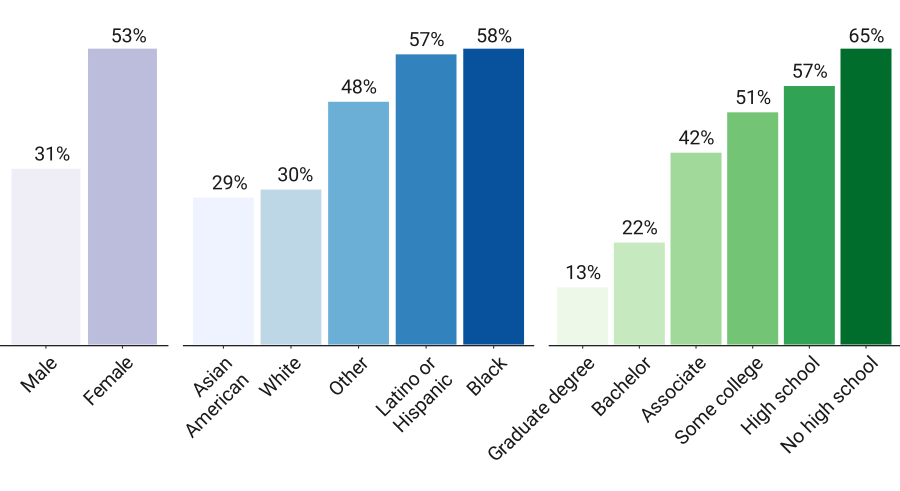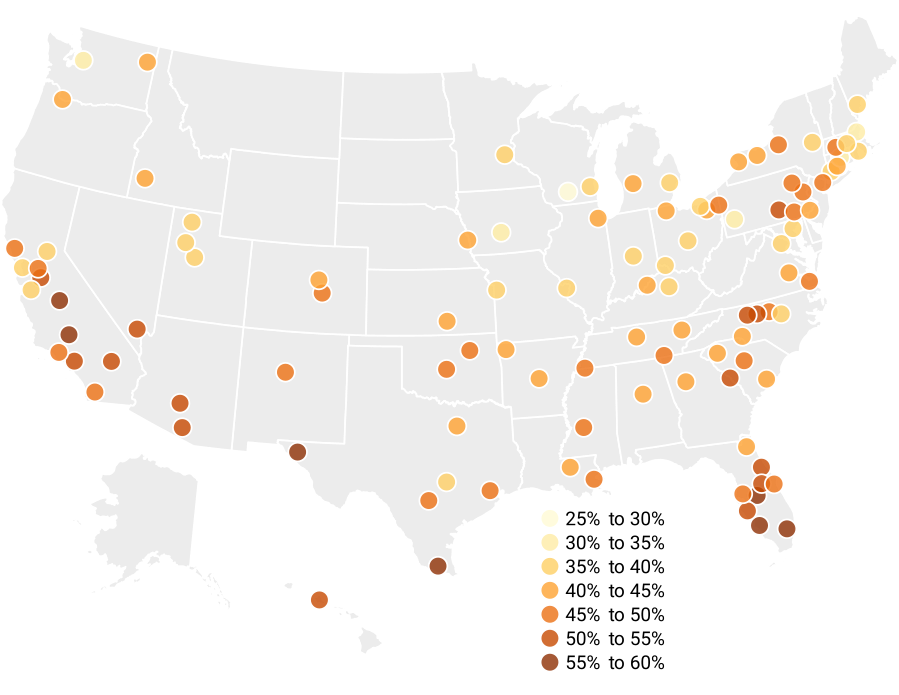
How family sustaining jobs can power an inclusive recovery in America’s regional economies
America has a wage problem.
Before the pandemic hit, 44% of U.S. families in 2019 did not earn an income that was high enough to cover their families’ living expenses. Markedly, families headed by women (53%), Black (58%), and Latino or Hispanic (57%) individuals and individuals without a high school diploma (65%) are much more likely to be struggling economically.
The COVID-19 pandemic brought the low-wage crisis to new heights, as unemployed and underemployed low-wage workers—particularly women and people of color—face severe economic insecurity. In the depths of the COVID-19 pandemic, the economy shed low-wage jobs at eight times the rate of high-wage jobs.
Downloads
For those local and regional leaders responsible for crafting economic recovery strategies, there is intense pressure to grow back lost jobs and reconnect workers to them. But how will local leaders know if their recoveries are being driven by higher-quality jobs, and that those jobs are paying enough to lift families out of their current economic insecurity?
This report provides family-sustaining wage thresholds derived from pre-pandemic data that can guide public-private partnerships that want to rebuild a more socially stable and prosperous economy in the wake of COVID-19. Specifically, the report provides metrics on three key points of data aimed at local policymakers:
- Struggling families: Leaders must understand the baseline economic costs of sustaining a family in their region, and how many families with children were struggling to make ends meet.
- Family-sustaining wage thresholds: Leaders must understand the wages required to help those struggling families cover their cost of living, and the number of jobs that currently pay those wages.
- Family-sustaining wage job deficits: Leaders must understand the gap between the current number of family-sustaining wage jobs and what is required to lift a significant share of families out of struggling status.
Finding 1: Forty-four percent of families with children were struggling to make ends meet before COVID-19
Families headed by women, Black, and Latino or Hispanic individuals and individuals without a high school diploma are more likely to be struggling
Share of families with children that are struggling by household head

Source: Brookings analysis of American Community Survey 2019 data and Economic Policy Institute Family Budget Calculator data.
Shares of struggling families vary from 25% to nearly 60% in US metro areas
Share of families with children who are struggling in large and very large metro areas

Source: Brookings analysis of American Community Survey 2019 data and Economic Policy Institute Family Budget Calculator data.
These national trends mask striking variations at the local level. Among the 53 “very large” metro areas with populations exceeding 1 million residents, over 50% of families with children were struggling to make ends meet in Miami, Riverside, Calif., Los Angeles, Las Vegas, Phoenix, Orlando, Fla., and Tucson, Ariz. At the lower end of the spectrum, the share of struggling families was slightly above 30% for Pittsburgh, Boston, and Seattle.
“Large” metro areas (those with populations between 500,000 and 1 million) exhibit similarly high shares of struggling families with children. Shares range from nearly 60% in McAllen, Texas, Lakeland, Fla., El Paso, Texas, and Bakersfield, Calif. to about 30% in Madison, Wis., and Des Moines, Iowa.
Even at the low end, this means more than one-quarter of families with children are not being paid enough to make ends meet across major metro areas—and this was before the COVID-19 recession.
Finding 2: Only six metro areas offer median wages above the family-sustaining wage threshold
With 14 million households struggling to make ends meet, this report identifies, for every U.S. metro area, the family-sustaining wage threshold and the number of family-sustaining wage jobs required to move half of those struggling families with children into self-sufficiency. Importantly, the family sustaining wage is higher than the regional median wage in all but six metro areas—Hartford, Conn., Sacramento, Calif., Madison, Wis., Spokane, Wash., Seattle, and Washington, D.C.—suggesting that most local economies are not delivering enough high-quality jobs to support the cost of raising a family.
This feature requires an up-to-date modern browser such as Chrome, Firefox, Edge, or Safari.
…
As an example, 42% of families with children in the Chicago metro area do not earn enough high wages to make ends meet. To move half of these struggling families into self-sufficiency (212,123 families), the region needs 271,477 more jobs that pay a “family-sustaining” wage of $24.11 per hour.
How does this report define a family-sustaining wage threshold, and a family-sustaining wage job deficit?
This report defines a family-sustaining wage threshold as the wage level that would lift half of the region’s struggling families with children out of struggling status, given the families’ current earnings structures and number of wage earners.
This report defines a family-sustaining wage job deficit as the estimated number of jobs that pay family-sustaining wages that are needed to lift half of struggling families with children out of struggling status.
How we estimate family-sustaining wage thresholds and family-sustaining job deficits

Example: Share of struggling families that could make ends meet at different wage levels in the Birmingham metro area
Determining family-sustaining wage thresholds and family-sustaining job deficits in each region is an informed but ultimately somewhat arbitrary process. This interactive illustrates how family-sustaining wage thresholds shift as we lift a certain proportion of struggling households out of the struggling status for families with children, and for all families.
This feature requires an up-to-date modern browser such as Chrome, Firefox, Edge, or Safari.
…
Finding 3: Tradable and supply chain industries concentrate higher shares of family-sustaining jobs
Share of family-sustaining wage jobs across different industry segments
This feature requires an up-to-date modern browser such as Chrome, Firefox, Edge, or Safari.
…
Family-sustaining jobs are not spread evenly across every segment of the economy. According to recent research from Mercedes Delgado and Karen Mills, tradable and supply chain industries have unique attributes that lead to the creation of better-paid jobs.
Applying the industry classification framework developed by Delgado and Mills, this report finds that tradable industries—and particularly supply chain tradable services industries—are more likely to concentrate a higher share of family-sustaining wage jobs across major metro areas.
Yet, looking locally at these dynamics is critical as well. Depending on what types of jobs constitute the local industries and how wage levels compare to the family-sustaining wage threshold, the industries that provide high shares of family-sustaining jobs may vary significantly in different labor markets.
To address economic insecurity in the wake of COVID-19, policymakers would be wise to focus job creation strategies on:
- Talent development: Connecting struggling workers to family-sustaining jobs.
- Economic development: Targeting business growth in sectors that concentrate family-sustaining jobs.
- Raising the floor: Upgrading existing jobs that are not offering a family-sustaining wage.

